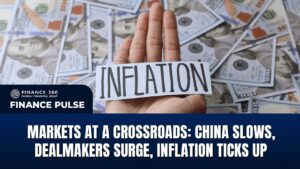President Donald Trump escalated tensions with one of America’s most vital trading partners late Thursday, threatening to impose a 35% tariff on goods imported from Canada, effective August 1. The move signals a dramatic shift in a trade relationship that has already endured years of uncertainty.
The announcement, part of what appears to be a broader hardline trade push, was accompanied by Trump’s comments during an interview with NBC News suggesting that blanket tariffs on other U.S. trading partners could soon increase as well.
“We’re just going to say all of the remaining countries are going to pay, whether it’s 20% or 15%. We’ll work that out now,” Trump told “Meet the Press” moderator Kristen Welker, according to NBC.
The Thursday threat is the latest in what has become a whipsaw policy approach, leaving investors, businesses, and trading partners struggling to navigate an economic environment that shifts rapidly. In many cases, the landscape has changed not just week to week, but hour to hour.
Scope of Tariffs Still Unclear
It remains uncertain whether Trump’s proposed 35% tariff would apply to all Canadian goods or only to specific imports currently subject to U.S. tariffs.
Canada’s Prime Minister Mark Carney stated social platform X:
“Throughout the current trade negotiations with the United States, the Canadian government has steadfastly defended our workers and businesses,” he said. “We will continue to do so as we work towards the revised deadline of August 1.”
Part of a Global Tariff Push
Trump’s threat to Canada came as part of a flurry of letters sent to nearly two dozen world leaders over the past week. These letters reportedly outlined new tariff rates to be implemented on August 1, barring the finalization of individual trade agreements.
Among the countries receiving letters, Canada is the largest U.S. trading partner to be contacted this week. Ongoing trade talks between the two nations have targeted a July 21 deadline for a final deal.
Canada purchased $349 billion worth of U.S. goods in the last year, making it America’s top export destination. Conversely, it exported $413 billion worth of goods to the United States, ranking as the third-largest foreign supplier to the U.S., according to Department of Commerce data.
Trade experts warn that imposing tariffs on Canadian goods could trigger retaliatory measures, potentially hurting American exporters. Trump, however, has preemptively warned that any such retaliation would be met with even higher tariffs.
A Pattern of Tariff Threats
Trump’s antagonism toward Canadian trade policy is not new. In November 2024, shortly after winning re-election, Trump pledged to impose 25% tariffs on all products from Canada and Mexico.
“Until such time as Drugs, in particular Fentanyl, and all Illegal Aliens stop this Invasion of our Country!” he said at the time.
While those tariffs were briefly delayed, they took effect on March 6, albeit with significant exemptions for goods compliant with the U.S.-Mexico-Canada Agreement (USMCA), which Trump negotiated during his first term.
A day later, on March 7, he threatened new levies on Canadian lumber and dairy, citing Canada’s protectionist trade barriers.
“Canada has been ripping us off for years on lumber and on dairy products,” Trump said in an Oval Office address.
“America would match those tariffs dollar-for-dollar.”
Those tariffs, however, were never implemented.
More recently, Trump took aim at a retroactive digital services tax proposed by Canada — a policy that would have primarily impacted large American tech firms. Canada postponed the tax at the last minute in hopes of keeping trade negotiations alive and avoiding further tariffs.






